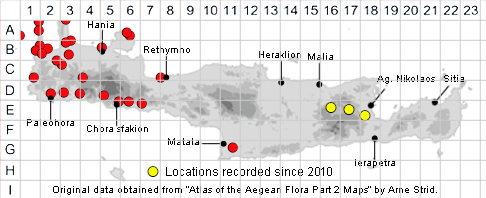
SPECIES DESCRIPTION
INULA CANDIDA subsp. CANDIDA
Family:- COMPOSITAEA/CANDIDA Group
Common Names:- None
Synonyms:- Inula candida, Inula limonifolia
Meaning:- Inula (L) A name used by the Roman naturalist and philosopher Pliny.
Candida (L) Shining-white.
General description:- Perennial, whitish-silvery shrub.
Stems:-
1) Up to c. 30 cm, slender, simple or with few short branches in the upper 1/3. The
indumentum appressed-sericeous-tomentose.
Leaves:-
1) Simple, alternate.
2) Basal, 3-9 cm ovate to lanceolate, tomentose.
Flowers:-
1) Capitula medium-sized with yellowish florets, very tiny, difficult to be
observed, usually supported or enfold by several bracts.
2) Involucre 8-9 mm, bracts recurved, usually with an elongate apex.
Fruit:-
1) Achenes c. 2 mm, hairy; angled, not abruptly contracted below the pappus.
2) Pappus about twice as long as the achene, with 10-15 setae.
Key features:-
1) Outer involucral bracts more than ½ as long as the inner.
2) Most capitula subtended by 2 or more bracts.
3) Stem and leaves more or less densely appressed-sericeous-tomentose.
4) Leaves entire.
5) Involucral bracts recurved near the usually elongate apex.
6) Involucre 8-9(-11) mm.
7) Indumentum very dense.
8) Basal leaves 3-9 cm.
Habitat:- Calcareous rocky places, crevices & screes, flat clayey areas 0-1000(-
1400)m.
Distribution:- Endemic to Crete and Kythera. Rare in east Crete.
Flowering time:- May-july.
Photos by:- Steve Lenton
